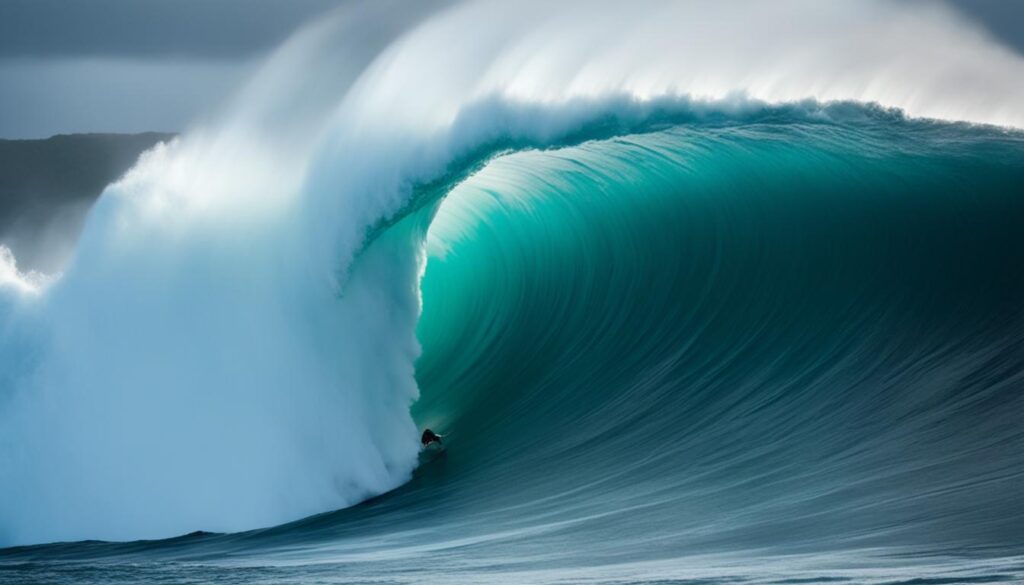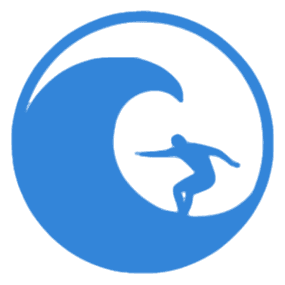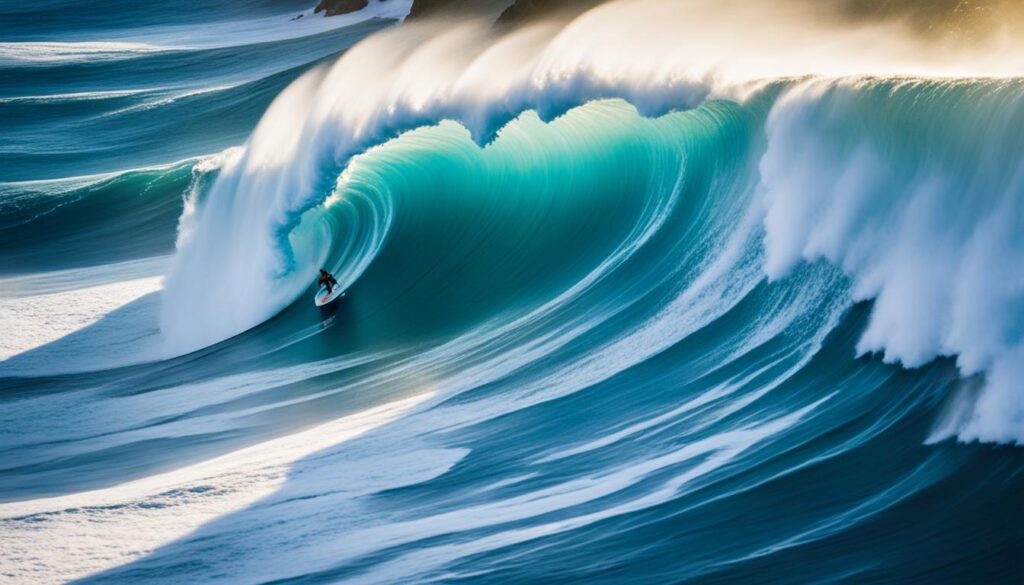As I gaze out at the relentless swells crashing against the rocks, I’m awestruck by the sheer power and scale of the ocean’s giants. These colossal waves, born from the convergence of distant storms and ancient geological forces, have captivated the human imagination for centuries. To witness their raw, untamed energy is to be humbled by the might of nature.
Yet, there are those who dare to conquer these ocean titans – the big wave surfers, a breed of daredevils who have dedicated their lives to taming the untamed. Their feats of bravery and skill have become the stuff of legend, pushing the boundaries of what was once thought possible. These are the true titans of the surf, the fearless waveriders who have etched their names into the annals of extreme sports history.
Key Takeaways
- The world’s biggest waves have captivated and awed people for centuries, showcasing the power and scale of the ocean’s forces.
- Big wave surfers are a breed of daredevils who have dedicated their lives to conquering these colossal ocean giants.
- Their feats of bravery and skill have become the stuff of legend, pushing the boundaries of what was once thought possible.
- These fearless waveriders are the true titans of the surf, leaving their mark on the annals of extreme sports history.
- Witnessing the raw, untamed energy of these monstrous swells is a humbling experience, underscoring the might of nature.
Waves of Unprecedented Scale
In the vast and mysterious realm of the ocean, where water meets sky and elemental forces collide, there exists a phenomenon that captures the awe and reverence of surfers, scientists, and adventurers alike – the biggest waves in the world. These colossal ocean waves, often referred to as the “giants of the ocean,” have captured the imagination of countless individuals, their towering walls of water representing the sheer power and unpredictability of the natural world.
Exploring the Colossal Giants of the Ocean Realm
Some of the biggest waves in recorded history have occurred at specific locations and events, showcasing the immense power and impact of the largest waves on the planet. For instance, the 1,720-foot wave that occurred in Lituya Bay, Alaska, stands as one of the most significant examples of these monstrous ocean swells. Similarly, the powerful 20-foot waves at Teahupo’o in Tahiti and the catastrophic 100-foot tsunami waves from the 2004 Indian Ocean event have demonstrated the sheer scale and devastation that the biggest waves in the world can unleash.
| Location | Wave Size | Noteworthy Factors |
|---|---|---|
| Lituya Bay, Alaska | 1,720 feet | One of the biggest waves in recorded history, caused by a landslide |
| Teahupo’o, Tahiti | 20 feet | Renowned for its powerful, hollow waves that have challenged the world’s best big wave surfers |
| 2004 Indian Ocean Tsunami | 100 feet | Devastating natural disaster that claimed thousands of lives and caused widespread destruction |
These historical occurrences showcase the immense power and impact of the largest waves on the planet, instilling a sense of reverence and respect for the sheer scale and force of these natural phenomena.
“The ocean has always been a salve to my soul, but these biggest waves in the world, the giants of the ocean, they command a level of respect that is both humbling and awe-inspiring.”
As surfers, scientists, and adventurers continue to explore and study these colossal ocean waves, the mysteries and challenges they present remain a captivating and compelling aspect of the ocean realm.
The Science Behind Monstrous Swells
The formation of the world’s biggest waves is a captivating interplay of natural forces and unique geological features. From powerful storms in the open ocean to the presence of deep underwater canyons, several factors contribute to the creation of these colossal waves.
One prime example is the Nazaré Canyon in Portugal, which acts as a natural funnel, amplifying and focusing the Atlantic Ocean’s swells into waves of record-breaking size and power. Understanding the science behind these monstrous swells is crucial in unlocking the mysteries of this awe-inspiring natural phenomenon.
Factors that Generate Monster Swells
- Powerful storms in the open ocean, generating immense wave energy
- Presence of deep underwater canyons that can act as natural wave amplifiers
- Interaction between swells and shallow coastlines, leading to wave transformation and growth
- Unique geological features that can focus and direct wave energy towards specific locations
The science behind giant waves is a complex interplay of these various factors, all coming together to create the colossal swells that challenge the world’s most fearless big wave surfers.
| Geological Feature | Effect on Wave Formation |
|---|---|
| Nazaré Canyon, Portugal | Acts as a natural funnel, amplifying and focusing Atlantic Ocean swells |
| Underwater Canyons | Can increase wave height and power through wave refraction and focusing |
| Shallow Coastlines | Transforms and amplifies incoming swells, leading to the creation of monster waves |
“Understanding the science behind these colossal waves is crucial in unlocking the mysteries of this awe-inspiring natural phenomenon.”
By delving deeper into the science behind these monstrous swells, we can gain a better appreciation for the sheer power and complexity of the ocean’s most extreme waves.
Legendary Big Wave Surf Spots
Across the globe, there are a number of renowned locations that have become synonymous with big wave surfing. From the legendary Nazaré in Portugal, where Garrett McNamara surfed a colossal 100-foot wave, to the premier big wave surfing destinations of Peahi (Jaws) in Maui, Hawaii, and the treacherous Mavericks in California, these spots have attracted the world’s most daring and skilled surfers. The unique geological features and weather patterns that create the ideal conditions for these monstrous waves also make them some of the world’s most challenging and dangerous surf breaks.
Where Giants Come to Life
Surfers who conquer these legendary big wave surf spots are revered as legends within the big wave community. The giants that come to life at these premier destinations test the limits of human ability and courage, challenging the world’s best waveriders to push the boundaries of the sport. From the powerful swells of Nazaré to the massive waves breaking at Jaws and Mavericks, these are the places where the colossal forces of nature converge, creating an unparalleled and awe-inspiring spectacle.
| Surf Spot | Location | Notable Features |
|---|---|---|
| Nazaré | Portugal | Home to some of the world’s largest waves, including a 100-foot wave surfed by Garrett McNamara. |
| Peahi (Jaws) | Maui, Hawaii | Known for its massive, powerful waves that can reach heights of over 60 feet. |
| Mavericks | California | Renowned for its treacherous, cold-water conditions and waves that can exceed 50 feet in height. |
These legendary big wave surf spots are where the giants of the ocean come to life, challenging the world’s most fearless and skilled surfers to conquer their colossal waves. The unique geological and weather conditions that create these monstrous swells also make them some of the most dangerous and thrilling surf breaks on the planet.
Record-Breaking Waves and Daring Feats
The pursuit of riding the world’s largest waves has driven some of the most remarkable feats in the history of big wave surfing. From Garrett McNamara’s record-breaking 100-foot wave at Nazaré, Portugal, to the daring paddle-in sessions at Jaws in Maui, Hawaii, big wave surfers have continually pushed the boundaries of what was thought possible.
These monumental wave riding achievements, often captured in heart-stopping imagery and video, have cemented the legacies of the fearless individuals who dare to take on the ocean’s most colossal giants. The relentless pursuit of pushing the limits of big wave surfing continues to captivate and inspire both the surfing community and the public at large.
| Record-Breaking Waves | Daring Big Wave Surfing Exploits |
|---|---|
| Garrett McNamara’s 100-foot wave at Nazaré, Portugal | Paddle-in sessions at Jaws, Maui, Hawaii |
| Maya Gabeira’s 73.5-foot wave at Nazaré, Portugal | Laird Hamilton’s tow-in surfing at Jaws, Maui, Hawaii |
| Rodrigo Koxa’s 80-foot wave at Nazaré, Portugal | Shane Dorian’s big wave exploits at Pe’ahi, Maui, Hawaii |
The relentless pursuit of pushing the limits of big wave surfing has produced some of the most daring and record-breaking exploits in the sport’s history. From colossal waves to fearless acts of athleticism, the world’s leading big wave surfers continue to captivate audiences and redefine the boundaries of what is possible in the realm of the ocean’s most powerful and awe-inspiring forces.
“The pursuit of riding the world’s largest waves has driven some of the most remarkable feats in the history of surfing.”
who surf the biggest wave
The surfers who conquer the world’s largest waves are a breed apart, possessing an unparalleled mix of skill, bravery, and passion for the sport. These big wave riding experts, daredevil big wave surfers, and titans of the surf have become synonymous with pushing the boundaries of what’s possible in the ocean.
Names like Garrett McNamara, Laird Hamilton, Greg Long, and Shane Dorian have earned the respect and admiration of the global surfing community for their fearless exploits. These fearless wave conquerors have honed their techniques and physical conditioning to a razor’s edge, allowing them to tackle waves of unprecedented scale and power.
Their willingness to risk it all in pursuit of riding the giants of the ocean has cemented their status as true legends of the sport. From the colossal swells of Nazaré in Portugal to the behemoths of Jaws in Maui, these who surf the biggest waves have proven time and again that the limits of human ability are constantly being redefined.
“Surfing the biggest waves is not just about skill – it’s about having the courage to face the raw power of the ocean and conquer your fears.”
As the sport of big wave surfing continues to evolve, the exploits of these titans of the surf will undoubtedly inspire a new generation of fearless wave conquerors to push the boundaries of what’s possible in the pursuit of riding the ultimate ocean giants.
The Risks and Dangers
Facing the Untamed Power of the Ocean
Big wave surfing is an inherently risky pursuit, with the potential for severe injury or even fatality ever-present for those who dare to take on the ocean’s mightiest giants. Wipeouts can result in surfers being pushed down 20 to 50 feet below the surface, struggling to regain their bearings and reach the air before the next wave crashes down. The immense water pressure can rupture eardrums, and powerful currents can slam surfers into the reef or seafloor.
Despite the risks of big wave surfing, thrill-seeking waveriders continue to push the boundaries, driven by an insatiable thirst for the adrenaline rush and the chance to conquer the untamed power of the ocean. The dangers of riding giant waves are well-documented, with numerous accounts of surfers sustaining life-threatening injuries, such as broken bones, internal bleeding, and even drowning.
The hazards of tackling colossal swells are not to be underestimated. Big wave surfing is fraught with peril, from the risk of being held down by powerful white-water to the threat of being slammed against the seafloor or razor-sharp reef. Big wave surfing injuries and fatalities serve as a sobering reminder of the unforgiving nature of the sport.
“The ocean has a certain majesty, but it also has a very dark side. It can be incredibly beautiful, but it can also be incredibly violent and powerful.”
Despite the inherent dangers of big wave surfing, the allure of conquering the ocean’s giants remains strong for those who seek the ultimate challenge. The pursuit of this adrenaline-fueled pursuit is not for the faint of heart, as it requires a level of skill, courage, and unwavering determination that few possess.

Tow-In Surfing Revolution
The advent of tow-in surfing in the 1990s marked a pivotal moment in the world of big wave riding. Pioneered by surfers like Laird Hamilton, this revolutionary approach allowed athletes to be towed into waves by jet skis, granting them the speed and momentum needed to conquer colossal swells that were previously inaccessible through traditional paddle-in techniques.
The tow-in surfing revolution has expanded the boundaries of what is possible in the realm of big wave riding, captivating both the surfing community and the wider public. This innovative method not only enabled surfers to tackle waves of unprecedented size but also facilitated the use of smaller, more maneuverable boards that offered greater control and agility.
The jet ski-assisted wave catching has significantly increased the accessibility of giant waves, allowing surfers to push the limits of their abilities and reach new heights in the sport. The thrilling and adrenaline-fueled nature of tow-in surfing has captured the imagination of audiences worldwide, propelling big wave riding into the spotlight as a true spectacle of human achievement.
“The tow-in surfing revolution has forever changed the way we approach big wave riding. It has unlocked a new frontier of possibilities, transforming the sport in ways we could never have imagined.”
As the tow-in surfing revolution continues to evolve, the sport has witnessed a remarkable surge in popularity, inspiring a new generation of daring waveriders to push the boundaries of what is possible in the vast and untamed ocean realm.
The Surf Legends
The pantheon of big wave surf legends is populated by a select few individuals who have etched their names into the sport’s history through their extraordinary feats and unwavering courage. Figures like Garrett McNamara, Laird Hamilton, Greg Long, and Shane Dorian have become revered as renowned big wave surfers within the surfing community, their exploits inspiring awe and admiration. These fearless waveriders have not only conquered the ocean’s mightiest giants but have also pushed the boundaries of what is possible in the sport, cementing their legacies as true titans of the surf.
Honoring the Fearless Waveriders
The stories of these iconic big wave riding exploits continue to captivate and inspire the next generation of big wave surfers. From Garrett McNamara’s record-breaking wave at Nazaré to Laird Hamilton’s pioneering of tow-in surfing, these big wave surf legends have left an indelible mark on the sport, their accomplishments serving as a benchmark for the fearless and the bold.
| Legendary Surfer | Notable Achievements |
|---|---|
| Garrett McNamara | Rode the largest wave ever surfed, a massive 78-foot wave at Nazaré, Portugal in 2011. |
| Laird Hamilton | Considered the godfather of big wave surfing, pioneered the use of tow-in surfing to tackle the largest waves. |
| Greg Long | Multiple-time winner of the Big Wave Tour and the Eddie Aikau Big Wave Invitational. |
| Shane Dorian | One of the most decorated big wave surfers, known for his fearless approach and technical prowess. |
These titans of the surf have not only redefined the limits of what is possible in big wave surfing but have also inspired countless others to push their own boundaries and seek out the most awe-inspiring waves on the planet. Their legacies will continue to shape the future of this thrilling and and demanding sport.
“To ride a giant wave, you have to be willing to die. It’s that simple. You can’t be afraid of it.”
– Laird Hamilton, legendary big wave surfer
The Future of Big Wave Surfing
As the sport of big wave surfing continues to evolve, the future holds the promise of even greater feats and advancements. With the ongoing development of new technologies, the increasing skill and physical conditioning of athletes, and the relentless drive to conquer the ocean’s most colossal giants, the boundaries of what is possible in big wave riding are continually being expanded.
The pursuit of surfing the biggest waves on the planet will undoubtedly remain a captivating and awe-inspiring endeavor, attracting the world’s most daring and skilled surfers and captivating audiences with their feats of bravery and athleticism. Advanced wetsuit technologies, improvements in tow-in systems, and the utilization of artificial intelligence in wave prediction are just a few examples of the technological innovations that are poised to push the limits of the sport even further.
The future of big wave surfing is poised to deliver even more remarkable achievements and push the limits of human potential in the face of nature’s most powerful forces. As the continued evolution of giant wave conquest unfolds, the world will bear witness to the unwavering dedication and indomitable spirit of the athletes who dare to conquer the ocean’s most formidable giants.
FAQ
What are the biggest waves that have been recorded in history?
What factors contribute to the formation of the world’s biggest waves?
Where are the most renowned locations for big wave surfing?
What are some of the remarkable feats of big wave surfing?
Who are the legends of big wave surfing?
What are the risks and dangers associated with big wave surfing?
How has the advent of tow-in surfing impacted the world of big wave riding?
What does the future hold for big wave surfing?
Source Links
- 7 of The Biggest Waves in the World – https://www.rapturecamps.com/blog/7-biggest-waves-in-the-world/
- Portugal’s Monster: The Mechanics Of A Massive Wave – https://www.npr.org/sections/thetwo-way/2013/01/31/170753700/portugals-monster-the-mechanics-of-a-massive-wave
- Big wave surfing – https://en.wikipedia.org/wiki/Big_wave_surfing

